A surprising statistic shows that in April 2023, the Komisyon sa Wikang Filipino (KWF) suggested using “Filipinas” instead of “Pilipinas.” This has started a big debate about the country’s name and its role in national identity. The term “Filipinas” was first used in the 16th century, during the Spanish colony. It stands for modernization and national identity.
The change from “P” to “F” in “Filipinas” marks a shift. It shows the country’s history and growth as a nation. This is key to understanding national identity and the process of changing names.
Exploring the Philippines’ name history and the arguments for and against changing it is interesting. We can visit historical sites to learn about the country’s past and its link to national identity. The Philippines has been in a debate about changing its name. Some say it should be changed to “Filipinas” to honor its history and growth, which is vital for national identity and name change.
Key Takeaways
- The Komisyon sa Wikang Filipino (KWF) proposed changing the country’s name to “Filipinas” in April 2023, which has sparked a debate about national identity and name change.
- The term “Filipinas” was first used in the 16th century and symbolizes modernization and national identity, highlighting the importance of name change in shaping national identity.
- The change from “P” to “F” in “Filipinas” represents a shift towards recognizing the country’s history and development as a nation, which is closely tied to the concept of national identity.
- The proposal to change the country’s name is not new, with previous attempts including changing the name to “Maharlika” in 1978, which was not adopted, and highlights the complexities of the name change process and its impact on national identity.
- The debate about changing the Philippines’ name raises important questions about national identity and how it is shaped by a country’s name, emphasizing the need to consider the implications of name change on national identity.
- The process of name change is closely tied to the concept of national identity, and it is essential to consider the potential impact of a name change on the country’s national identity and its people.
- The Philippines’ national identity is closely tied to its history and development as a nation, and the proposal to change the country’s name to “Filipinas” highlights the importance of considering the implications of name change on national identity.
The Origin Story: How the Philippines Got Its Name
The Philippines’ name has a rich history, starting with the Spanish colonial period. Its colonial heritage is key to understanding its name. In 1543, Spanish explorer Ruy López de Villalobos named the islands after King Philip II of Spain.
Before the Spanish came, the islands were known as “Islas Filipinas” and “Las Islas de San Lazaro”. The name “Philippines” started with Leyte, Samar, and nearby islands. It later grew to cover the whole archipelago, becoming a big part of the country’s Philippines history.
Some other names for the Philippines include:
- Panyupayana
- Ma-i
- Las islas de San Lázaro
These names show the country’s rich cultural and historical background. It was shaped by its colonial heritage and Philippines history.

Historical Attempts to Change the Philippines’ Name
The Philippines has faced many attempts to change its name. Some believe it should reflect the country’s culture and history. In the 1970s, dictator Ferdinand Marcos wanted to rename it “Maharlika”.
Recently, President Rodrigo Duterte also suggested “Maharlika”. He said it comes from Sanskrit, meaning “serenity and peace”. He sees it as a way to highlight Filipino culture and leave the colonial past behind.
Several events have shaped the Philippines’ history and identity. These include:
- 1542: The Philippines was named after the heir to the Spanish throne.
- 1898: The Proclamation of independence by revolutionary forces marked the beginning of the country’s struggle for self-rule.
- 1946: The Philippines gained full independence from the United States, leading to the establishment of the Republic of the Philippines.

The debate on a name change is ongoing in the Philippines. Some think it’s needed to promote Filipino culture. Others see it as a waste of money.
The Current Push for a New Name
The debate on changing the Philippines’ name has been ongoing. Many want a name that better reflects the country’s national identity. The proposal to change it to “Filipinas” has been suggested, citing a KWF resolution.
This move aims to break free from colonial ties and boost national pride. It’s about reclaiming the country’s history and culture.
A name change could greatly impact the country’s image. Some see it as a necessary step, while others think it’s unnecessary and could cause confusion. The debate has sparked a lively discussion among Filipinos.

Modern Advocates and Their Arguments
Modern advocates for a name change see it as a way to move beyond the colonial past. They believe a new name would better reflect the country’s culture and history. It’s seen as a step towards reclaiming the country’s heritage.
Popular Alternative Names Proposed
Popular alternative names include “Filipinas”, “Maharlika”, and “Luzviminda”. Each name has its own significance and meaning. Proponents argue they would better reflect the country’s national identity.
Public Reception and Debate
The public’s reaction to the proposal is mixed. Some support the idea of a name change, while others oppose it. The debate has sparked a lively discussion.
It’s a matter of national identity for some, while others see it as a relic of the past. The decision to change the country’s name will depend on the Filipino people’s will and the government’s willingness to implement it.
Cultural Identity in the Modern Philippines
The Philippines is a country with a rich and diverse Filipino culture. It has over 182 ethnolinguistic groups. This diversity greatly shapes the country’s national identity.
The idea of “Pinoy Pride” captures the national pride and identity of Filipinos. This pride comes from the country’s history, culture, and traditions. It’s what makes the Philippines unique.
Understanding cultural identity in the modern Philippines is key. It helps us grasp the debate over changing the country’s name.
Some key aspects of Filipino culture include:
- A strong sense of community and family ties
- A vibrant arts and culture scene, with a mix of traditional and modern influences
- A diverse range of languages, with over 135 recognized local indigenous Austronesian languages
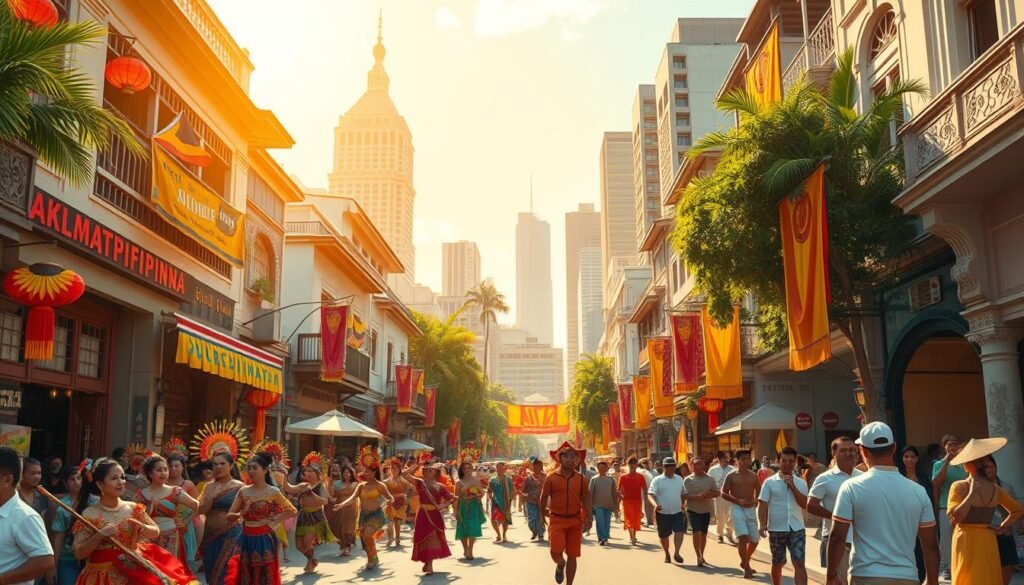
In conclusion, Filipino culture and national identity are closely tied. Any talk of changing the country’s name must consider these factors. By valuing the diversity and richness of Filipino culture, we can better understand national identity and what it means to be Filipino.
The Cost of National Rebranding
Changing a country’s name, like the Philippines, comes with big costs. It takes a lot of time, money, and effort. Updating documents like passports and driver’s licenses is just the beginning.
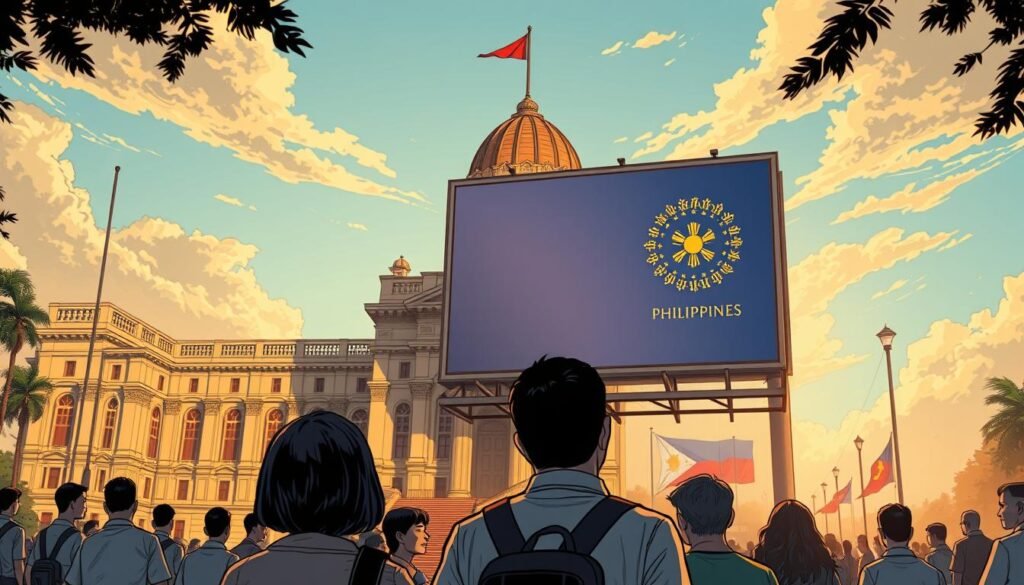
Economic Factors
The economic effects of renaming a country are huge. Changing branding and marketing materials, like websites and social media, costs a lot. For instance, renaming Swaziland to eSwatini cost around $6 million.
Administrative Challenges
There are also big administrative hurdles. Getting the world to recognize the new name can take years. Plus, updating the currency, including coins and banknotes, could cost hundreds of millions of lilangeni.
- Estimated cost of changing the name from Swaziland to eSwatini: $6 million
- Cost of updating currency: hundreds of millions of lilangeni
- Time taken for international recognition: several years
In conclusion, the cost of renaming a country is a big deal. The economic and administrative challenges need careful thought before deciding.
Learning from Other Countries: Name Change Case Studies
When thinking about a name change, looking at other countries is key. They’ve gone through similar changes. This gives us insights into the ups and downs of rebranding a nation.
A country’s national identity is closely linked to its name. Changing it can deeply affect its people and how it’s seen globally. For example, Indonesia’s switch from “Dutch East Indies” to “Indonesia” in 1945 was a big step towards its independence.
Some countries have successfully changed their names. Here are a few examples:
- Myanmar, which changed from “Burma” in 1989
- Indonesia, which changed from “Dutch East Indies” in 1945
These stories show that changing a country’s name is complex. It involves a deep look at its history, culture, and identity.
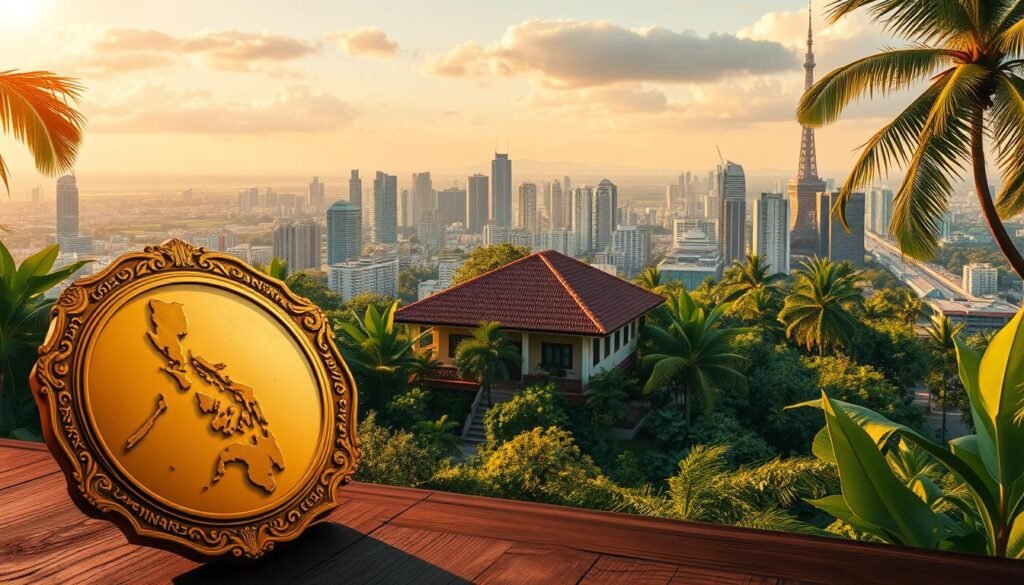
In summary, learning from other countries’ experiences with name changes is helpful. It can guide the Philippines as it thinks about its own identity and potential name change. By studying successes and challenges, the Philippines can make a better choice for its future.
The Role of Colonial Heritage in National Identity
The Philippines’ colonial past greatly shapes its national identity. The country’s name, language, and culture were all influenced by its colonial history. Today, we still feel the effects of colonialism.
It’s key to understand how colonial heritage impacts national identity. Colonial heritage includes social, cultural, and economic changes from colonial times.
Colonial Influence on Filipino Culture
The Spanish rule lasted over three centuries, deeply affecting Filipino culture. Christianity, the Spanish language, and Western customs shaped a unique Filipino identity.
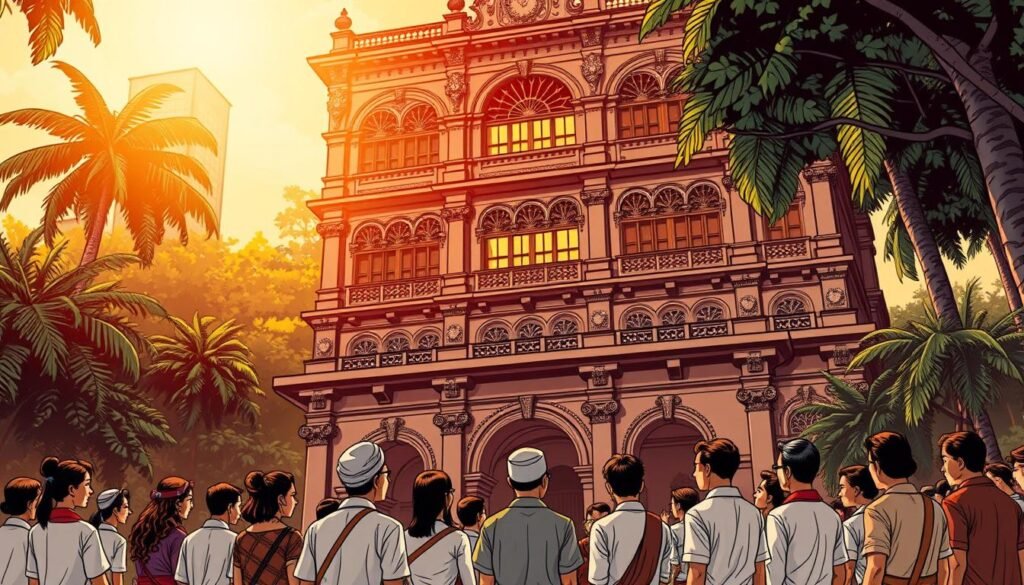
Now, there’s a push to preserve and celebrate the Philippines’ national identity. Efforts include restoring historic sites and promoting cultural events. These aim to honor the country’s rich heritage.
Decolonization Movements
But, there are also movements against colonialism. They aim to challenge old power structures and narratives. These groups work to give a more accurate view of history and empower marginalized communities.
The impact of colonial heritage on national identity is complex. It has deeply influenced culture and society. Yet, we must also work to decolonize and reclaim our history and heritage.
Legal Framework for a New Name
Changing the Philippines’ name would need a big change in the country’s legal framework. This means changing the constitution, which needs a two-thirds vote in both the House and Senate. The name change would also mean updating laws and rules to match the new name.
One important part of this legal framework is making sure there are no legal problems with the name change. This includes changing business names, licenses, permits, and tax documents. It might also mean updating internal systems and legal papers.
Some key things to think about in the legal framework for a name change are:
- Constitutional amendment requirements
- Updates to laws and regulations
- Comprehensive reviews to mitigate potential legal disputes
- Updating business registrations, licenses, permits, and tax filings
It’s crucial to plan carefully for the name change. We need to think about how it will affect the country’s legal framework. We should also make sure the transition to the new name goes smoothly. This means being open with everyone involved to build trust and loyalty.
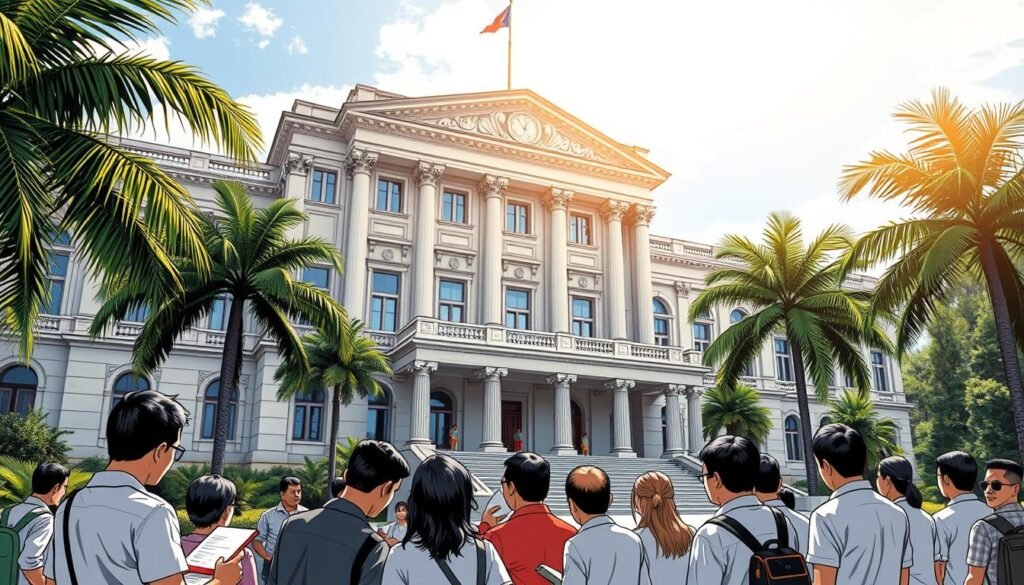
Impact on International Relations and Diplomacy
A name change could greatly affect the Philippines’ international relations. It would need updates to treaties and agreements with other countries. Getting the international community to recognize the new name could be complex and slow.
The Philippines’ role in international relations has grown over time. This growth reflects its national interests shaped by history and reality. In 1946, it gained independence from the U.S., allowing it to engage more in international relations. Today, it’s a UN member and has signed many international agreements, including the 1987 Constitution.
Some challenges the Philippines might face with a name change include:
- Updating treaties and agreements with other countries
- Gaining recognition for the new name from the international community
- Ensuring compliance with international law and norms
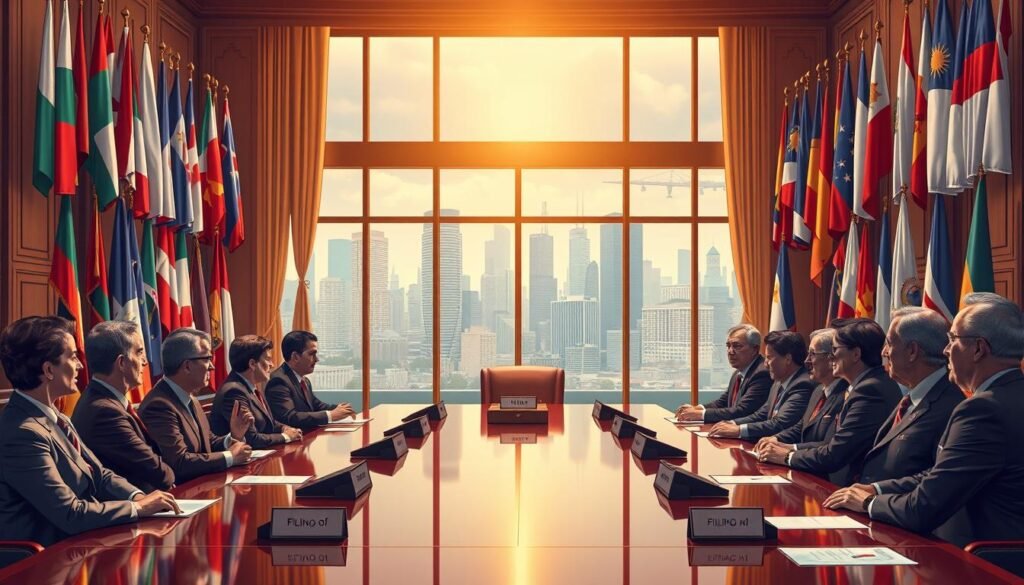
The study of international relations has changed a lot since World War II. This change is seen in North America and Western Europe, due to Cold War geostrategic concerns. The field of international relations uses many disciplines, like anthropology, economics, and history. This shows a broad approach to understanding global issues.
Public Opinion: What Do Filipinos Think?
The debate on changing the Philippines’ name has sparked a lot of talk among Filipinos. Public opinion is split on this topic. Some think a name change is needed to show the country’s true identity. Others believe it’s not needed and could cause confusion.
A survey by Pew Research showed that most Filipino adults have good views of many countries. But, opinions on changing the country’s name are more mixed. Some Filipinos are hesitant to change the name because of its historical value.
Some main worries about a name change include:
* It might confuse both foreigners and locals
* It could be expensive to rebrand the country
* It might affect the country’s identity and pride
Understanding public opinion on this topic is key to deciding if a name change is good for the Philippines. By looking at what Filipinos think and considering both sides, leaders can make a choice that truly represents the people’s wishes.
The Language Factor: Filipino vs Pilipino
The debate on changing the Philippines’ name is linked to its language. This language is key in forming the country’s identity. The idea to rename the country from “Philippines” to “Filipinas” has raised questions about language’s role in this change.
The Filipino language, also known as Pilipino, has seen big changes. It is spoken by over 83 million people and has roots in Tagalog. The first Tagalog dictionary was published in 1613. The Komisyon sa Wikang Filipino (KWF) has helped make Filipino the national language.
Linguistic Evolution
The switch from Pilipino to Filipino aims for more inclusivity in Philippine identity. The new Filipino alphabet includes letters like F and V, not found in Pilipino. This change shows the country’s effort to meet its people’s needs and foster unity.
Regional Language Considerations
The Philippines has over 175 living languages, each with its own culture and importance. Using Filipino as the national language helps unite different regions and ethnic groups. Yet, worries about how a name change might affect regional languages and cultures remain.
The language factor is crucial in the debate over the Philippines’ name change. As the country considers a new name, it must think about its national language and identity. Understanding the complex ties between language, culture, and identity will help Filipinos make informed decisions about their country’s future.
| Language | Number of Speakers |
|---|---|
| Filipino (L1) | 29 million |
| Filipino (L2) | 54 million |
| Total | 83 million |
Economic Considerations of a Name Change
A name change for the Philippines could lead to big economic implications. It would cost a lot to update official documents and get international recognition. The country would also have to spend on new branding and marketing, like websites and social media.
Changing the country’s name would mean updating many government documents. This includes passports, driver’s licenses, and birth certificates. It would be expensive and hard to manage. The country would also have to think about how it affects trade and business, including possible confusion.
Some important economic implications of a name change are:
- Cost of updating official documents and international recognition
- Investment in new branding and marketing materials
- Potential impact on trade and commerce
It’s crucial to think about these economic implications before deciding on a name change. The country needs to balance the possible benefits of a name change against the costs and challenges.
Cultural Heritage Preservation
Keeping a nation’s national identity alive is key. The Philippines, with its rich history and diverse culture, has a heritage worth protecting. As it thinks about changing its name, preserving its cultural heritage is crucial. The idea of cultural heritage includes both physical things like buildings and intangible ones like traditions.
It’s important to keep cultural heritage alive for many reasons. It helps keep the country’s culture strong and boosts tourism, which can help the economy. Countries like China have shown how to protect their heritage, like with an Intangible Cultural Heritage Protection Network. By finding a balance between old and new, the Philippines can safeguard its heritage for the future.
Indigenous Perspectives
Indigenous views are vital in preserving cultural heritage. They offer a special look into the country’s past and cultural ways. The Philippines is home to many indigenous groups, each with their own traditions.
By including these views in preservation efforts, the country can truly represent its diverse people. This way, the cultural heritage of the Philippines will be rich and varied.
Digital Age Implications
In the digital age, a name change for the Philippines would mean big changes. With 89% of adults online, updating the country’s digital presence would be key. This includes changing websites, social media, and marketing to show the new name.
Changing the country’s name online would be a big task. It would need updates to domain names, website content, and social media. Also, all digital tools must show the new name. In 2021, over $1.59 trillion was spent on digital changes, showing the big effort needed.
Another important thing is how a name change affects search engines. With more online content, a new name could change how people find the Philippines online. A good plan for online content is crucial to keep the country visible online.
In short, changing the Philippines’ name online needs careful planning. It requires a big investment in digital updates and a solid content strategy. By understanding these steps, the Philippines can smoothly adapt and stay visible globally.
Future Identity: Beyond the Name Debate
The idea of national identity is more than just a name change. As the Philippines moves forward, it’s key to create a national brand that shows off its culture and values. This will help boost national pride and future identity. To do this, the country should invest in education, tourism, and cultural programs.
Research from exploring the concept of identity shows a strong national identity is vital. It helps build a united and welcoming society. By celebrating its cultural heritage and shared values, the Philippines can create a strong national identity that goes beyond borders.
National Branding Strategies
Here are some ideas for national branding for the Philippines:
- Develop a unique logo that shows off the country’s culture
- Create a slogan that captures the Filipino spirit
- Boost tourism by improving infrastructure and highlighting natural and cultural spots
Building a Modern Filipino Identity
To build a modern Filipino identity, we need to understand the country’s history, culture, and values. By embracing diversity and inclusivity, the Philippines can grow national pride and future identity. This identity should reflect the country’s rich cultural heritage.
Conclusion
The debate on changing the Philippines’ name is complex. It shows the country’s ongoing fight to assert its national identity. Some suggest changing the name to “Filipinas,” which has sparked a lot of discussion.
This change could affect the country’s cultural heritage and its relations with other nations. It’s important to think about these impacts carefully.
Many people in the Philippines want a name change. This shows a strong interest in national identity. The country’s future identity will balance its cultural heritage with modern values.
This balance will lead to a meaningful conclusion to the name change debate. The Philippines is on a journey to strengthen its national identity.
It’s key to involve the public and listen to different views on this topic. This way, the country can move towards a unified vision for its future. This vision will reflect the values and dreams of its people, ending the debate.
FAQ
What is the origin of the Philippines’ name?
The name “Philippines” comes from Spanish explorer Ruy López de Villalobos. He named it in 1543, in honor of King Philip II of Spain. Before the Spanish arrived, the country was known as “Islas Filipinas” and “Las Islas de San Lazaro”.
Why are some people proposing to change the Philippines’ name to “Filipinas”?
Some want to change the name to “Filipinas” to better reflect the country’s history and culture. They believe it will help the country assert its national identity and move away from its colonial past.
What are the potential implications of changing the Philippines’ name?
Changing the name would require a lot of time, money, and effort. It would mean updating official documents and getting international recognition. It could also affect the country’s international relations and diplomacy.
How would a name change affect the country’s cultural heritage?
Changing the name could impact the country’s cultural heritage. It might lead to the loss of historical and cultural references. Yet, it could also be a chance to rebrand and reposition the country’s cultural identity.
What is the role of colonial heritage in shaping the Philippines’ national identity?
The Philippines’ colonial past greatly influences its national identity. The country’s name, language, and culture all show this influence. Understanding this is key to the debate on changing the country’s name.
How would a name change affect the country’s economy?
Changing the name could have big economic effects. It would cost a lot to update documents and get international recognition. It could also impact trade and commerce. The country would need to spend on new branding and marketing, including its website and social media.
What is the public’s opinion on changing the Philippines’ name?
Opinions on changing the name are mixed. Some see it as a way to assert national identity. Others think it’s unnecessary and could cause confusion.
How would a name change affect the country’s language and linguistic identity?
Changing the name could impact the country’s language and identity. The proposal to change to “Filipinas” has sparked a debate about language’s role in national identity.
What can the Philippines learn from other countries that have changed their names?
The Philippines can learn from countries like Indonesia and Myanmar. They’ve faced challenges and found opportunities in changing their names. Their experiences offer valuable insights.
How would a name change affect the country’s digital presence and online identity?
A name change would require a big update to the country’s online presence. It would need to update its website, social media, and digital marketing. The country would have to invest in its digital infrastructure, including its domain name and social media handles.
What is the future of the Philippines’ national identity, and how can it be shaped?
The Philippines’ national identity is complex and will evolve. It will balance its rich cultural heritage with modern values. The country needs a national branding strategy that reflects its culture and values, promoting national pride and identity.
Source Links
- End of ‘Philippines?’ A call to use only Filipinas for the country
- What’s in a name?
- History of the Philippines | People, Spain, United States, Revolution, Map, & Facts | Britannica
- Names of the Philippines
- Philippines profile – Timeline
- Philippine independence declared | June 12, 1898 | HISTORY
- New name could push back against old stigma at evolved Genesee County animal shelter
- How can I push a local Git branch to a remote with a different name easily?
- Culture of the Philippines
- In Focus: Cultural Identity and Development – National Commission for Culture and the Arts
- The cost of changing a country’s name
- Cost for Naming a Company – Determining a Budget – Tungsten Branding
- Rebranding is Expensive. Is it Worth It?
- 10 Examples of Famous Businesses That Changed Their Names
- Top 10 International Business Negotiation Case Studies
- Is colonial heritage negative or not so much? Debating heritage discourses and selective interpretation of Kulangsu, China – Built Heritage
- Cultural Nationalism | The Role of Culture in National Identity
- Understanding the Legal Framework for Company Name Changes
- How to Perform a Legal Name Change in California
- International relations
- The Year in Public Opinion on U.S. K–12 Education Policy
- 9. How well the major parties represent Americans, the public’s feelings about more political parties
- Polling & Public Opinion: The good, the bad, and the ugly
- Filipino language
- Filipino vs. Pilipino: What’s the Difference?
- What Would Be The Economic Impact Of A Redskins Name Change?
- Name change in the United States brought economic payoff
- Cultural Heritage Preservation
- Developmental Sustainability through Heritage Preservation: Two Chinese Case Studies
- Cultural heritage
- 4 Characteristics of Modern Digital Transformation–and Content Implications – Content Science Review
- Social remembering in the digital age: Implications for virtual study, work, and social engagement | Memory, Mind & Media | Cambridge Core
- The clinical implications of digital technology
- Are You the Same Person You Used to Be?
- Locke on Personal Identity
- How your name affects your personality
- Refine Your Final Word With 10 Alternatives To "In Conclusion"
- Conclusions | UM RhetLab
- Conclusions – The Writing Center • University of North Carolina at Chapel Hill

